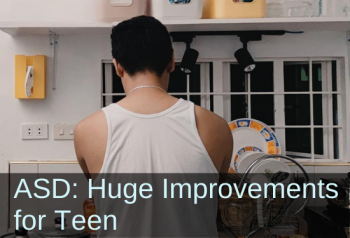Telehealth Sessions Relieve Anxiety, Bring Focus for 18 YO with Autism
Submitted by Emily E Nemec, OTD, OTR/L

|
Before
|
After
|
|
Difficulty focusing
|
Able to pay attention for much longer periods
|
|
Anxious
|
Handles anxiety and transitions much more easily
|
|
Difficulty coordinating use of both arms and crossing midline
|
More comfortable in his body; improved quality and control of movement
|
|
Had trouble completing multi-step tasks independently
|
More independent in routines and tasks
|
Jordan is an 18-year-old man with a diagnosis of autism spectrum disorder. Jordan’s mom previously told me that she has long suspected some additional neurological trauma (e.g. possible stroke in-utero) impacting Jordan’s motor function. Jordan is primarily non-speaking and communicates by typing in a text-to-speech application on his tablet. He presents with hyperactivity and seeks frequent vestibular and proprioceptive input. He has been observed to toe-walk, frequently works at a too-rapid pace resulting in errors, and has difficulty crossing midline, coordinating use of both arms, and following or imitating motor instructions.
Treatment occurred in 8 sessions over the course of 4 months via teletherapy per family request due to medical needs of Jordan and one of his family members during the COVID-19 pandemic. As I worked through the Brain and Sensory Foundations, First Level course, I coached Jordan and his mom on incorporating rhythmic movements, playful developmental movements, and additional reflex integration strategies into their daily movement routines. Jordan had previously received in-person treatment from me in his school, where I was able to conduct thorough observations of movement patterns (however, this was prior to initiating the course).
Jordan presented with observable symptoms, movements, and behaviors that indicated retention of the following reflexes: TLR, ATNR, STNR, foot reflexes, FPR, and Moro Reflex.
Because there were signs of so many unintegrated reflexes, I chose to create a home movement program using strategies to integrate all the reflexes taught in [the Brain and Sensory Foundations course] Due to Jordan’s difficulty with motor control, impulsivity, and attention, all exercises needed to be either interactive/play-based or able to be passively implemented by his parents. I chose to start with rhythmic movements to prime Jordan’s nervous system for later work on reflex integration, promote more fluid and coordinated movement, and to help him manage anxiety that may be associated with his retained FPR and Moro reflexes.
I taught the rhythmic movements by demonstrating through telehealth, creating a visual handout for the family with drawings and notes, and observing Jordan and his mom engaging in the movements via telehealth. It was difficult not being able to physically guide Jordan and his mom in person, but we worked closely together to make sure that Jordan and his mom felt very comfortable implementing these tools. Jordan’s mom did the rhythmic movements independently for a week at first to build her confidence in providing them to Jordan, and continued to use them as she worked with her son.
Jordan’s mom worked on passive rhythmic movements on Jordan for two weeks before checking in again, and in that short time she shared with me that she already saw big improvements in fluidity of movement and ability to cross midline in their daily exercise routines!
After these two weeks, I began collaborating with mom to find ways to incorporate movements that targeted reflex stimulation and integration that were play-based and engaging for Jordan. We added developmental movements with an animal theme – for example, crawling on all fours like a cat, army crawl like an alligator, cat and cow poses from yoga, and downward dog. I also introduced cross crawls. Jordan loved doing these activities with mom, and he continued to make big improvements in his quality and control of movement.
We did hit a snag a few weeks in – Jordan’s mom reported to me that she had seen great progress with crossing midline, but suddenly Jordan was having trouble with it again. We chatted for a little while to problem solve and try to understand why this was happening, and it turned out that Jordan and mom had stopped doing rhythmic movements! I was amazed that when they added the movements back in, crossing midline slowly became easier for Jordan again.
After about two months, Jordan was actively participating in rhythmic movements and could do many developmental movements independently. His parents reported that he was able to pay attention for much longer periods, could complete more complex multi-step tasks like chores independently, and seemed generally more comfortable in his body and confident with his movements. At this time, we began to slowly introduce isometric movements with both mom and dad helping to facilitate since Jordan still had difficulty following directions related to body movements. Every two weeks, we adjusted and added to the home program.
Now, at four months, Jordan moves like a very different person. He continues to require a lot of support for communication needs, emotional regulation, and impulsivity. But he can move with confidence and fluidity, he is more independent in routines at home that he used to need a lot of parent help for, and (most important to parents) he seems to handle anxiety and transitions much, much more easily.
These movements came to Jordan’s life at a time of great stress and change with the COVID-19 pandemic. His mother credits his increased ability to cope with sudden shifts in routines and expectations with his consistent engagement in these movements. Jordan’s family plans to continue using rhythmic movements and developmental movements in their daily routines, and will also use isometric activities as needed.
Because Jordan is still learning virtually, his teachers and other school staff have not yet had the chance to fully observe all these positive changes in Jordan, but I am confident he will be more independent in his school routines and better able to attend to classes and complete complex tasks in his school environment.
(Edited, emphasis added)


